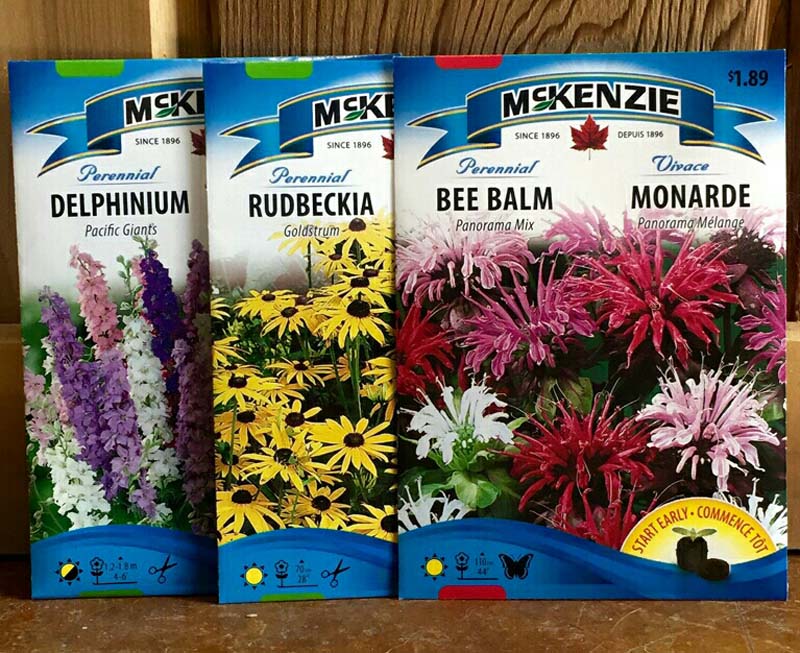Last week we talked about getting prepared to seed, specifically by taking care to sanitize seeding supplies, cleaning up the overall work area, buying premium seeding mix, and also investing in a journal to record your growing adventure. This week we look at some great perennials to seed in the next month!
A Few Notes about Seed
Just as animals come in all shapes and sizes with different requirements to thrive, so do plants, and accordingly their seeds. We are lucky enough to have access to literally thousands of different varieties of seeds that we can grow; the key to germinating and growing them on correctly is to mimic their natural habitat as closely as possible. You want to grow ornamental prairie grass? Chances are that germinating this seed will require thorough waterings with ample drainage, good air circulation, relatively cool night temperatures (ie. Less than 18 degrees Celsius), and only the most basic of fertilizer. Want to grow cactus plants from seed? These seeds will require very minimal moisture (and will take several weeks – a couple months to germinate), high light, and high heat. If ever in doubt as to what the seeds you are trying to grow require, think about their natural habitat first; more often than not, this bit of information will help you in your quest to grow the best seedlings on the block! Always read the seed packet instructions as well, as valuable information such as requirements for light, moisture, and temperature will be listed in the germinating details.
Now is the time to seed most of the varieties of perennial seed. Typically, the bigger the mature plant, the earlier in the year you need to seed. At our production greenhouses south of Langdon, we are busily seeding tray after tray of fabulous perennial. With over 200 varieties being produced by seed in our germination chambers, there are a few that have stood out over the seasons for ease of germination, reliable growth, efficient growing-on, and of course superior aesthetics! Here is my top 5 list of perennials to start from seed in the next month. Each variety listed is great to grow without expensive, supplemental lighting systems…simply a sunny window is all you need!
• Bee Balm (Monarda didyma) : A great performer in sun or shade, bergamot is a hardy perennial that features gorgeous, airy blooms atop sturdy plants. Fragrant and edible (square stems are a great indication that this plant is in the mint family), you can enjoy bee balm leaves or flowers as a garnish to salad, steeped in boiling water to make tea, or packed into sachets of potpourri. Several varieties are available; with plant heights ranging from 18″-36″ and flower colors of white, pinks, purple, and red.
• Poppy (Papaver) : Arguably one of the easiest perennial seeds to germinate, perennial poppies come in dozens of sizes and colors. Choose oriental varieties for large idyllic red/orange blooms reminiscent of the famous 1928 Georgia O’Keefe painting. (Recent genetics have also resulted in oriental poppies with pink and white blooms, however these seeds tend to be less consistent and germination/growing on can be troublesome.) If you are looking for perennial poppies in white/pink/orange/yellow, select the alpine or bubbles-type; these seeds are easy to germinate and grow effortlessly into pretty, compact basal rosettes of leaves with elegant stems hosting colorful flowers. Seed oriental varieties by Mar 15; seed alpine and bubbles-types by April 01.
• Purple Coneflower (Echinacea purpurea) : Here’s another very hardy, beautiful perennial that doubles as an edible. Growing around 30in tall with fabulous light-purple, large daisy-like blooms, this beauty loves the elements, growing well in dry, sunny, exposed areas. While herbalists the world over have argued about the best way to harvest purple coneflower (leaves, stems, roots, etc…and in tinctures, as powder, in pills, etc.), for the home gardener, knowing that the purple petals are edible is probably sufficient, and no further harvesting is accordingly necessary. I like throwing in just a few of the petals to salad or as a neat topping to dessert. Keep the stems to dry and use in fall arrangements; the flower centre is large and prickly, giving credence to its Greek name (“echinos” in Greek means hedgehog.)
• Delphinium (delphinium) : Every great garden with a few hours of sunlight deserves a delphinium of some sort; they are simply too beautiful to ignore. Home gardeners can’t go wrong here, with varieties ranging from dwarf to 6ft tall, and in colors spanning white, pink, purple, and even periwinkle. Members of the buttercup family, these plants produce towers of blooms that add luxuriant glamor to any planting, attract butterflies and hummingbirds, and last for weeks as cut flowers in the house.
• Hardy Black Eyed Susan (Rudbeckia fulgida) : Also known as orange coneflower, rudbeckia fulgida is a member of the aster family (not to be confused with purple coneflower, a member of the composite family.) This long-lived, very hardy, floriferous perennial fits into any sunny landscape that incorporates yellow or orange. Reliably growing to heights of 36in and more, this plant produces amazing 2-3in wide blooms for months, is generally parasite and pathogen free, requires no staking, is an important source for local pollinators, and is tolerant of most soil types.
What better way to keep your New Year’s resolution of living better than to try your hand at growing from seed this year? Taking 10min each day to look after and cultivate life does more than just produce beautiful plants at a low cost; it is a peaceful and fulfilling endeavor that adds joy to the human experience!
Let the Seeding Begin!

In response to Canada's Online News Act and Meta (Facebook and Instagram) removing access to Canada's local news from their platforms, Anchor Media Inc encourages you to get your news directly from your trusted source by bookmarking this site and downloading the Rogue Radio App. Send your news tips, story ideas, pictures, and videos to info@anchormedia.ca.









